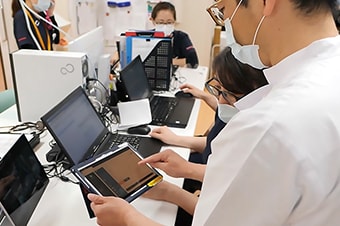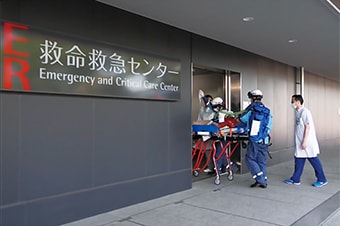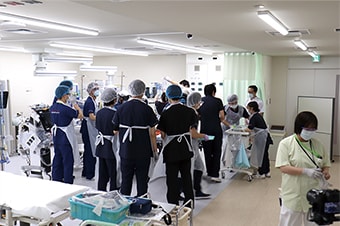Data AnalysisData analysis and AI utilization
Various information necessary for emergency medical care is predicted by data analysis and the use of AI to support the creation of a more secure emergency system.
We are currently conducting research on predictive diagnosis using AI for stroke and acute coronary syndromes, which are one of the three major diseases.
We have reported in a paper(*) on the high prediction accuracy, including the subcategories of each disease.
The implementation of AI in this field is expected to lead to prompt and optimum treatment, and to improve life-saving and reduce sequelae.
- * Paper published in the international scientific journal Scientific Reports.
- ʻA prehospital diagnostic algorithm for strokes using machine learning: a prospective observational studyʼ
- ʻPrehospital diagnostic algorithm for acute coronary syndrome using machine learning: a prospective observational studyʼ
AI forecasting for emergency
and appropriate allocation
By using machine learning to analyze past emergency dispatch data and predict in advance the time and location of frequent emergency calls, the system aims to improve the lifesaving rate by efficiently deploying emergency services and shortening the arrival time of emergency services at the scene.
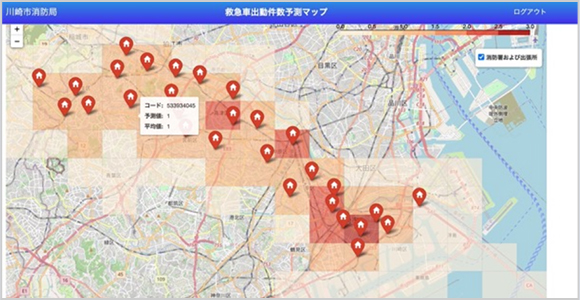
Map showing the number of ambulance calls. The number of ambulance calls per 4 hours is analyzed and visualized by dividing the relevant area into 2 km squares.
(From the Kawasaki City experiment).
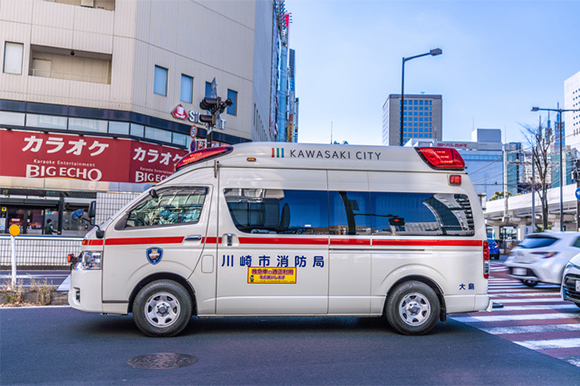
Started in Kawasaki City in April 2023.
The emergency demand forecasting AI was adopted for the “Commissioned work to shorten the arrival time of emergency services using AI” in Kawasaki City, Kanagawa Prefecture, after its effectiveness was recognized through an experiment.
Labor management data analysis
of ambulance crews
Past emergency dispatch data is analyzed, and the level of fatigue is visualized from the activity time and driving time of the emergency crews. By setting indicators for the shift times of paramedics and agency personnel and carrying out labor management, accidents can be prevented.
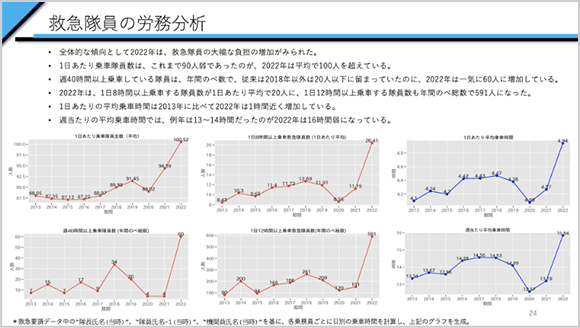
The system analyses the labor of paramedics from a multifaceted perspective, such as “total number of passengers per day” and “number of passengers over 40 hours per week”, based on past emergency dispatch data.
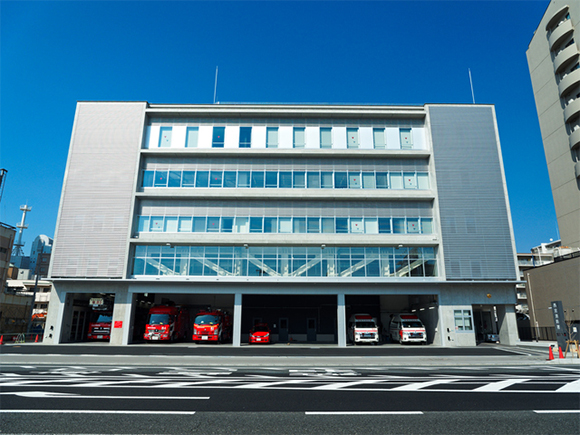
Hospital Selection AI
(Transfer Transport Prediction AI)
Predicts the probability of transfer to a hospital for each medical institution by inputting the information of the injured or sick person and the condition of the injured or sick person based on past data.
By performing hospital selection based on the prediction results, transferring to a different hospital is prevented.
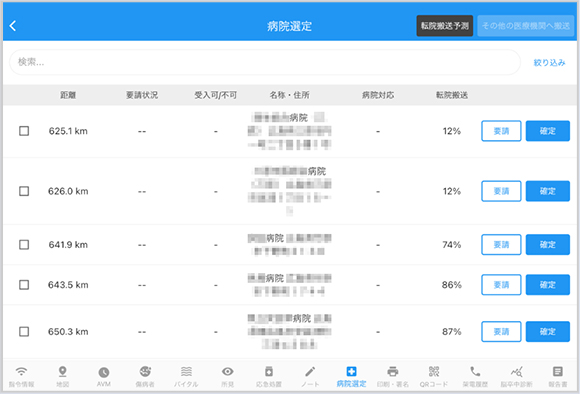
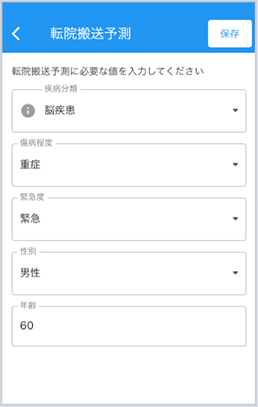
On the Hospital Selection Screen, the AI calculates and displays the probability of transfer to a hospital based on the information of the injured or sick person and the accumulated past symptoms.
This prevents transfer to another hospital and supports more accurate selection of the hospital where the patient should be transferred.
Started in Higashihiroshima City in April 2023
Smart119” has been installed and is being used by 13 medical institutions in Hiroshima Prefecture as the “Higashihiroshima City Emergency Operation System (HECRS)”.
One of the aims of Higashihiroshima City in implementing this system was to improve the emergency issue of “reducing transfers to hospital”.
For this reason, “Transfer Prediction AI” was developed and installed as a new function of “Smart119” to solve this problem.
AdvantagesWhat Smart119 can do
Streamline emergency calls
and emergency operations
 119 input
119 input Command
Command Emergency
Emergency
response Arrival
Arrival
on site
Use of firefighting OA data
Reduce arrival time at the scene, etc.
Solution by AI
 Hospital
Hospital
selection Request for
Request for
admission Hospital
Hospital
transfer Hospital
Hospital
arrival Doctor
Doctor
handover
Information sharing with
medical institutions
Reduced time spent on site and in the hospital
Solution through the power of ICT!
 Return to
Return to
oneʼs office Report
Report
writing Ex-post
Ex-post
facto review
Reflected in the report
Easy report generation
Reduced report generation time
Reduced workload!
The system reduces the workload of the emergency services and optimizes and streamlines their emergency activities.
The system enables citizens to access appropriate medical care as quickly as possible.
The real-time sharing system facilitates the ʻrelay of lifeʼ between residents, fire command centers, emergency teams and receiving medical institutions.
Current situation:
conventional relay system
The emergency services select a hospital,
call in patient information one by one and negotiate acceptance,
thus increasing the time spent on site.
Smart119:
Real-time sharing method
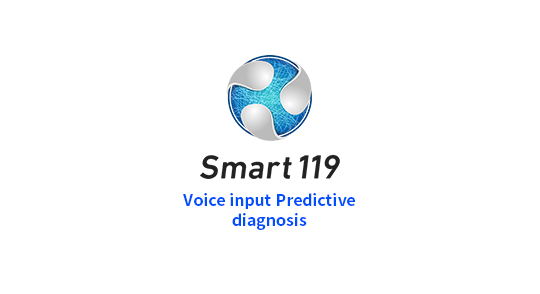
OperationOperation method
Operation at Chiba City Fire Department from July 2020.
Operation will start in April 2023 in Higashihiroshima City.

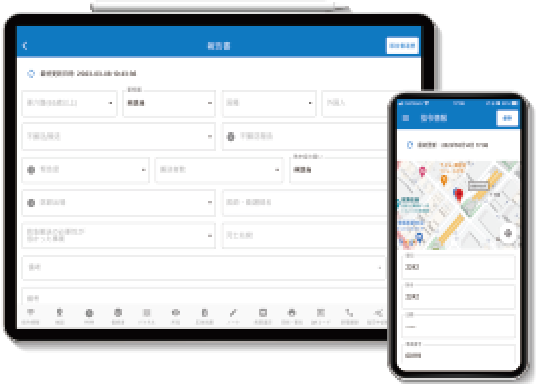
Two devices such as iPhone / iPad
can be used at the same time.
- Example
- iPhone……
for taking photos and hospital contact at the scene of a disaster site - iPad……
for making handover documents and reports in the ambulance
![]() Command center
Command center
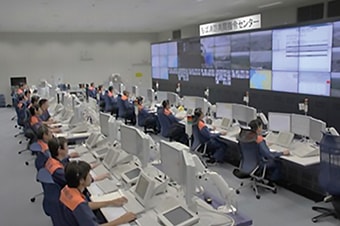
At the command center where the 119 call is received, the information from the caller is sent to the terminal of the emergency services and the case is started automatically.
* The emergency services are not obliged to link up with the command system.
If no link is made, the paramedics can set up the case by themselves.


![]() Paramedics
Paramedics
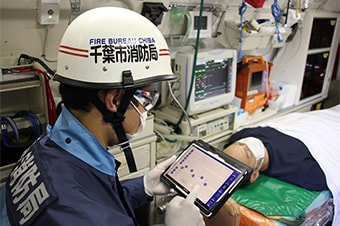
The paramedics check the information on the command system and the call and go to the site.
After arriving at the site, they can enter information on the injured or sick person and their vitals into the terminal and, if necessary, take and send photos of the accident site.
The entered information of the injured or sick person is shared with the medical institutions and can be used as a basis for decisions making for accepting the patient.
The information can be shared with several medical institutions at the same time, and you can receive an online response as to whether they can accept the request or not.


![]() Medical institutions
Medical institutions
When medical institutions receive a request for admission from the emergency services and information on the injured or sick person, they can make a decision based on the vital information and images on the screen. As a lot of information can be received accurately and promptly, it is possible to prepare for the acceptance.
In addition, the time spent by the emergency team in the hospital can be shortened by digitizing the doctorʼs signature when taking over from the emergency team (signatures can be made at any time from the hospitalʼs devices) and by making the handover form paperless.
Information on injured and sick patients received from the emergency team can be reflected in the electronic medical record after the handover.

FunctionFunctions
This function reduces the workload of the emergency team and optimizes efficiency.
Voice recognition
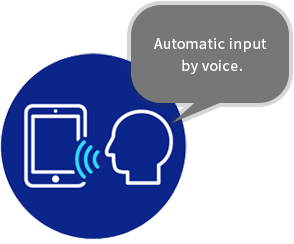
Reduces workload with voice recognition
When the paramedics enter information on the injured or sick person, the voice of the paramedics is recognized, converted into text, and automatically entered into the tablet.
This function reduces the workload on site and shortens the time spent by the emergency services on site.
OCR function (AVM/Driverʼs license/insurance card)

The system can be customized
for each fire department.
When the vital data of the injured or sick person in the ambulance, the AVM(*) display screen showing the location of the ambulance, or visual information such as the injured or sick personʼs insurance card or driverʼs license is photographed with the tablet camera, the text data is recognized and automatically entered as the injured or sick personʼs information.
* Automatic Vehicle Monitoring
Automatic acquisition of vitals by linking to a electrode monitor
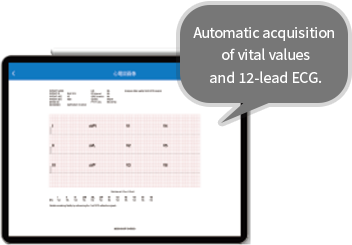
Linking with a PM monitor
In conjunction with the patient monitoring device in the ambulance, the measured vital values and electrocardiogram data are automatically taken into the tablet.
The captured data can be shared with medical institutions.
AchievementIntroduction results
Digitalization introduction of emergency medical care to make life safer and more secure for the citizens of the city.
We want to facilitate the sharing of information between command centers, emergency services and medical institutions using ICT, to transport many people as quickly as possible, and to save as many lives as possible.
Smart119, developed with this in mind, has been installed in local authorities across the country and is being used on the frontline.
By introducing Digitalization to emergency medical care, we support the emergency services that quickly rush to the injured and sick, and the medical institutions that have established
an emergency medical system and accept patients, and continue to contribute to the creation of safe communities where people can live with peace of mind.
System operation
- Chiba City (July 2020)
- After three years of collaboration between Chiba University and the Chiba City Fire Department, the “Smart119 Emergency Medical Information Service” was introduced to the Chiba City Fire Department (command center and 25 ambulances).
In the footing collapse at a high-rise apartment building in 2021, the emergency services used Smart119 to immediately send photos and information about the situation at the scene to the medical institution, which decided where to transport the injured before rescuing them.
At the receiving medical institution, appropriate reception preparations could be carried out based on the shared information, leading to speedy transport and the start of treatment.
- Higashihiroshima City (April 2023)
- The system was introduced with the aim of improving the five emergency issues faced by Higashihiroshima City: reducing the time emergency teams spend at the scene, reducing the time emergency teams spend at the hospital, reducing the time spent preparing emergency reports, reducing inter-hospital (transfer) transports, and linking data from various systems.
The system is called Higashihiroshima City Emergency Operation System (HECRS) and is used by 13 medical institutions in Hiroshima Prefecture, including the Higashihiroshima City Fire Department, Higashihiroshima Medical Centre in Higashihiroshima City, secondary emergency medical institutions, Hiroshima University Hospital and doctor helicopters outside the city.
In addition to the existing functions, three new functions have been newly developed and implemented to solve the issues faced by the city: a reporting function, an AI function for predicting hospital transfers, and a function for linking with patient monitoring equipment.
- Chiba Prefecture (to be expanded sequentially to 54 municipalities in the prefecture from April 2023)
- Smart119 Inc. was selected by Chiba Prefecture as a contractor for the “Entry of the Support System for Emergency Medical Services” to improve the quality of emergency medical services and prefectural services.
Before the introduction of the system, emergency teams in the prefecture had to call potential medical institutions one by one to explain the symptoms of emergency patients and confirm whether they could accept them.
By introducing Smart119 to 31 fire departments (227 emergency teams) and 150 medical institutions in the prefecture, including the Chiba City Fire Department, which has already introduced the system, it is expected to speed up the decision on where to transport patients and improve the lifesaving rate throughout the prefecture.
Data analysis and use of AI
- Kawasaki City (April 2023) Emergency Demand Forecasting AI
- Kawasaki City, where the arrival time of emergency teams tended to increase due to overcrowding of the cityʼs airmass, is considering improving the efficiency of emergency transport by forecasting emergency demand using AI as a measure to shorten arrival time at the scene and increase the possibility of saving lives.
Based on the ʻCollaboration Agreement on a Demonstration Experiment to Shorten the Arrival Time of Emergency Services Using AIʼ concluded with Smart119, a demonstration experiment was conducted.
The verification was carried out using an emergency demand forecasting AI developed by analyzing the cityʼs big data on past emergency dispatches and using machine learning methods. By identifying in advance, the locations where emergency calls are most likely to occur, the AI facilitates the efficient allocation of ambulances and emergency services in the city.
The results of the experiment showed that emergency demand can be predicted with a high degree of accuracy and that the time required to arrive at the scene can be shortened through the appropriate allocation of ambulances.
DemonstrationMunicipal and administrative
demonstration experiments
We propose the digitalization on emergency medical care.
Smart119 will continue to develop and improve systems that aim to improve the efficiency of emergency services, reduce the workload, and increase the lifesaving rate, in order to promote the digitalization on of emergency medical care, which is urgently needed by many government services, and support the construction of high-quality emergency medical systems tailored to the needs of each local authority.
We will continue to actively collaborate with local authorities across the country and carry out demonstrations to solve problems faced by local communities.

